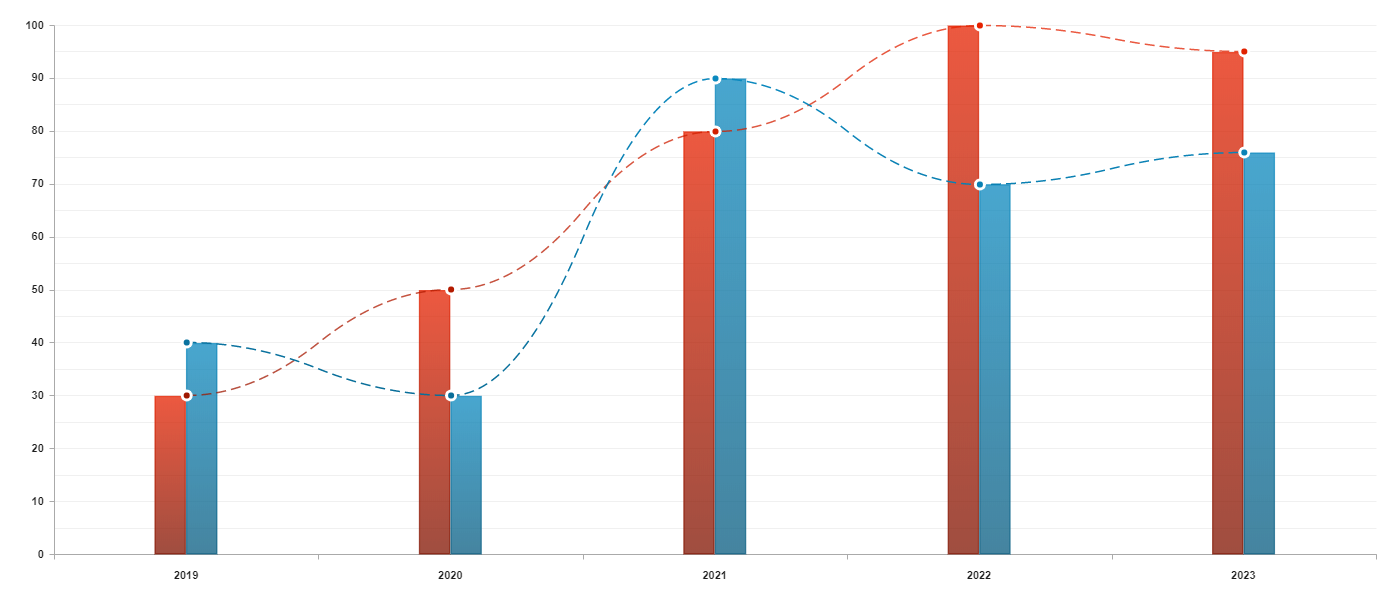README
GraphJS
About
GraphJS is javascript library to create flexible graphs. It uses pure javascript to draw charts on canvas.
Installation
npm install web-graphs
Example
Code
<canvas width="1400" height="700"></canvas>
const canvas = document.querySelector('canvas');
let grid = new CoordinateSystem2dGrid(canvas, {
x: new ValueLabel(-100, 100, 50),
y: new FlexLabel(100, 0, 20)
});
grid.addCharts({
line: new LineChart({
fill: true,
dots: true,
smooth: true,
values: [{
color: ['#005B80', '#00B6FF'],
values: [25, 70, 65, 50, 30]
}, {
color: ['#FF00AA', '#800055'],
values: [[-30, -60, -40, -70], [-16 , -10, -40], [-70, -65, -65, -100, -90], [-70, -75, -85], -70]
}]
})
});
grid.draw();
Output

Documentation
Labels
String label
It will create named ranges.
- values - array of names
- reverse - reverses direction of label
Code
interface StringLabel(values: string[], {reverse?: boolean} = {});
let label = new StringLabel(['Monday', 'Tuesday', 'Wednesday', 'Thursday', 'Friday', 'Saturday', 'Sunday']);
let label = new StringLabel(['Monday', 'Tuesday', 'Wednesday', 'Thursday', 'Friday', 'Saturday', 'Sunday'], {reverse: true});
Output

Value label
It is using to determinate points how the charts should be draw.
- start - first number of label
- end - last number of label
- step - step to next number
- reverse - reverses direction of label
Code
interface ValueLabel(start: number, end: number, step: number, {reverse?: boolean} = {});
let label1 = new ValueLabel(-100, 100, 50);
let label2 = new ValueLabel(100, -100, 25);
let label3 = new ValueLabel(100, -80, 20, {reverse: true});
Output

Flex label
It is same thing as ValueLabel but it will automativly change its start, end and step according to charts values.
- start - first number of label
- end - last number of label
- step - step to next number
Code
interface FlexLabel(start: number = 0, end: number = 100, step: number = 20);
let label1 = new FlexLabel();
let label2 = new FlexLabel(-100, 100, 50);
let label3 = new FlexLabel(100, -100, 25);
Output

Percent label
It is using to determinate points how the charts should be draw. It takes values from 0 to 100.
- step - step to next number
- reverse - reverses direction of label
Code
interface PercentLabel(step: number, {reverse?: boolean} = {});
let label = new PercentLabel(20);
let label = new PercentLabel(20, {reverse: true});
Output

Grids
List of methods that you can use on any grid: If you don't know how to create single chart or grid you can find it below.
- addCharts - Adds charts to your grid. You can find witch of chart can be added to witch grid below. You can name them whatever you like but it have to be unique.
- draw - Draws grid with all of the charts.
- chartList - You can find all of the chart that are assigned to your grid here.
| Horizontal | Vertical | CoordinateSystem2d | CoordinateSystem1d | Polygon | No | |
|---|---|---|---|---|---|---|
| Line | yes | - | yes | - | - | - |
| Column | yes | - | yes | - | - | - |
| Row | - | yes | yes | - | - | - |
| Buble | - | - | yes | - | - | - |
| Range | - | - | - | yes | - | - |
| Polygon | - | - | - | - | yes | - |
| Round | - | - | - | - | - | yes |
| SameDirectionRound | - | - | - | - | - | yes |
let grid = new PolygonGrid(canvas, new StringLabel(['a','b','c']));
let chart = new PolygonChart({values: [{color: '#00f', values: [10,30,40,50,20]}]});
grid.addCharts({
name: chart
});
grid.draw();
let myPolygonChart = grid.chartList.name;
HorizontalGrid
Click here to jump Grid methods It creates 2d plane with values/string labels.
- canvas - html canvas element
- top right bottom left - direction labels
- mainLabel - Grid will be draw by this label. Moreover all charts will be coresponding to this label. Default 'left'. It can not be StringLabel
- secondaryLabel - By this label charts will be signed. It must be StringLabel
- factor - more about facotrs
Code
interface HorizontalGrid(canvas: HTMLCanvasElement, {
top?: Label,
right?: Label,
bottom?: Label,
left?: Label
}, {
mainLabel?: 'left' | 'right',
secondaryLabel?: 'bottom' | 'top',
factor?: GridFactor
} = {});
let grid1 = new HorizontalGrid(canvas, {
top: new StringLabel(['Monday', 'Tuesday', 'Wednesday', 'Thursday', 'Friday', 'Saturday', 'Sunday'], {reverse: true}),
left: new PercentLabel(25),
bottom: new StringLabel(['Monday', 'Tuesday', 'Wednesday', 'Thursday', 'Friday', 'Saturday', 'Sunday']),
right: new FlexLabel()
});
let grid2 = new HorizontalGrid(canvas, {
left: new ValueLabel(100,0, 20),
bottom: new StringLabel(['Monday', 'Tuesday', 'Wednesday', 'Thursday', 'Friday', 'Saturday', 'Sunday']),
});
Output


VerticalGrid
Click here to jump Grid methods It creates 2d plane with string/values labels.
- canvas - html canvas element
- top right bottom left - direction labels
- mainLabel - Grid will be draw by this label. Moreover all charts will be coresponding to this label. Default 'bottom'. It can not be StringLabel
- secondaryLabel - By this label charts will be signed. It must be StringLabel
- factor - more about facotrs
Code
interface VerticalGrid(canvas: HTMLCanvasElement, {
top?: Label,
right?: Label,
bottom?: Label,
left?: Label
}, {
mainLabel?: 'top' | 'bottom',
secondaryLabel?: 'left' | 'right',
factor?: GridFactor
} = {});
let grid = new VerticalGrid(canvas, {
top: new ValueLabel(0, 100, 20),
right: new ValueLabel(100, 0, 25),
bottom: new ValueLabel(-100, 100, 20),
left: new StringLabel(['Monday', 'Tuesday', 'Wednesday', 'Thursday', 'Friday', 'Saturday', 'Sunday'])
});
let grid = new VerticalGrid(canvas, {
bottom: new ValueLabel(0, 100, 20),
left: new StringLabel(['Monday', 'Tuesday', 'Wednesday', 'Thursday', 'Friday', 'Saturday', 'Sunday'])
});
Output


CoordinateSystem2dGrid
Click here to jump Grid methods It creates 2d plane with x and y coordinates.
- canvas - html canvas element
- x y - direction labels
- factor - more about facotrs
Code
interface CoordinateSystem2dGrid(canvas: HTMLCanvasElement, {
x: ValueLabel | FlexLabel,
y: ValueLabel | FlexLabel
}, {factor: GridFactor});
let grid = new CoordinateSystem2dGrid(canvas, {
x: new ValueLabel(-100, 100 , 20),
y: new ValueLabel(100, -50, 25)
});
Output

CoordinateSystem1dGrid
Click here to jump Grid methods It creates One-Dimensional Coordinate System.
- canvas - html canvas element
- label - direction label
- factor - more about facotrs
Code
interface CoordinateSystem1dGrid(canvas: HTMLCanvasElement, label: ValueLabel | FlexLabel, { factor: GridFactor });
let grid = new CoordinateSystem1dGrid(canvas, new ValueLabel(-100, 100, 20));
Output

PolygonGrid
Click here to jump Grid methods It creates polygon grid with any number of vertices.
- canvas - html canvas element
- label - names of vertices
- factor - more about facotrs
Code
interface PolygonGrid(canvas: HTMLCanvasElement, label: StringLabel, { factor: GridFactor });
let grid = new PolygonGrid(
canvas,
new StringLabel(['Monday', 'Tuesday', 'Wednesday', 'Thursday', 'Friday', 'Saturday', 'Sunday'])
);
Output

NoGrid
Click here to jump Grid methods It creates empty grid. Is used for charts that don't need grid.
- canvas - html canvas element
Code
interface NoGrid(canvas: HTMLCanvasElement);
let grid = new NoGrid(canvas);
Charts
List of methods that you can use on any chart: If you don't know how to create single chart you can find it below.
content - It's a box were are all your that you passed to constructor or you've added later.
- getItemContent - Returnes item from your content by id.
- addItemContent - Add item to your chart content and returne it.
- updateItemContent - Updates item in your chart content by id and returnes it.
- deleteItemContent - Deletes item from your chart content by id and returnes it.
- createLabel - Appends labels generated from names of your items to element that you specify.
- draw - If your chart can be assigned to NoGrid you don't have to create new NoGrid and pass it to this grid. You can simply pass canvas to your chart and use this method.
- content - You can find here all your values that are in your chart.
- disable - By this value you can control if your chart will be displayed on the grid.
let chart = new PolygonChart({values: [{color: '#00f', values: [10,30,40,50,20], id: 1}]});
let item = chart.getItemContent(1);
let newItem = chart.addItemContent({color: '#f00', values: [20,40,65,30,10], id: 2});
let updatedItem = chart.updateItemContent(1, {color: '#0f0'});
let deletedItem = chart.deleteItemContent(2);
chart.createLabel(document.body);
chart.draw();
let content = chart.content;
chart.disable = true;
LineChart
Click here to jump Chart methods It creates lines on your grid.
- values - Each object in array is single line.
Item object:
- color - If you pass string it take its value as color. If you pass string array it will create gradient from this colors.
- values - If you pass number array the values will be pointing to the begining of the range. If you pass nested array it will be pointing to values between the range. You can see it in chart5.
- id - By this id you will be able to manage you item.
- name - It is the title of your item. It will allow you automaticly create label from your chart.
- dashLine - It takes array of number. It wors same as dash line in canvas.
- smooth - It somooths your line naturally.
- dots - It creates dots on the vertex.
- fill - It fills your line to the 0 point.
- correspondTo - By this you can choose to witch label it will be corresponding to.
- factor - more about facotrs
Example 1
Code
interface LineChart({
values?: [{
color: string | string[]
values: [number | number[]]
id?: string | number,
name?: string
}],
dashLine?: number[],
smooth?: boolean,
dots?: boolean,
fill?: boolean,
correspondTo?: string,
factor?: ChartFactor
});
let chart1 = new LineChart({
values: [{
color: '#FF2212',
values: [170,190,185,195,200,180,190,170]
}]
});
let chart2 = new LineChart({
dashLine: [10, 5],
values: [{
color: '#C229AD',
values: [150,180,145,185,170,150,170,150]
}]
});
let chart3 = new LineChart({
smooth: true,
values: [{
color: '#59BF0B',
values: [120,150,115,155,150,130,160,130]
}]
});
let chart4 = new LineChart({
dots: true,
values: [{
color: '#3D48EB',
values: [110,120,95,125,130,110,120,100]
}]
});
let chart5 = new LineChart({
dots: true,
values: [{
color: '#007785',
values: [[90,75,70],[80,90,80,70],[85, 60],80,[70, 60],[70, 80, 70, 60],[60, 70, 50, 80, 50, 40], 60]
}]
});
let chart6 = new LineChart({
fill: true,
values: [{
color: '#E8786D',
values: [40,60,25,65,30,50,40,10]
}]
});
let chart7 = new LineChart({
fill: true,
values: [{
color: ['#C21585', '#E62802'],
values: [-40,-50,-45,-35,-20,-40,-10,-20]
}]
});
Output
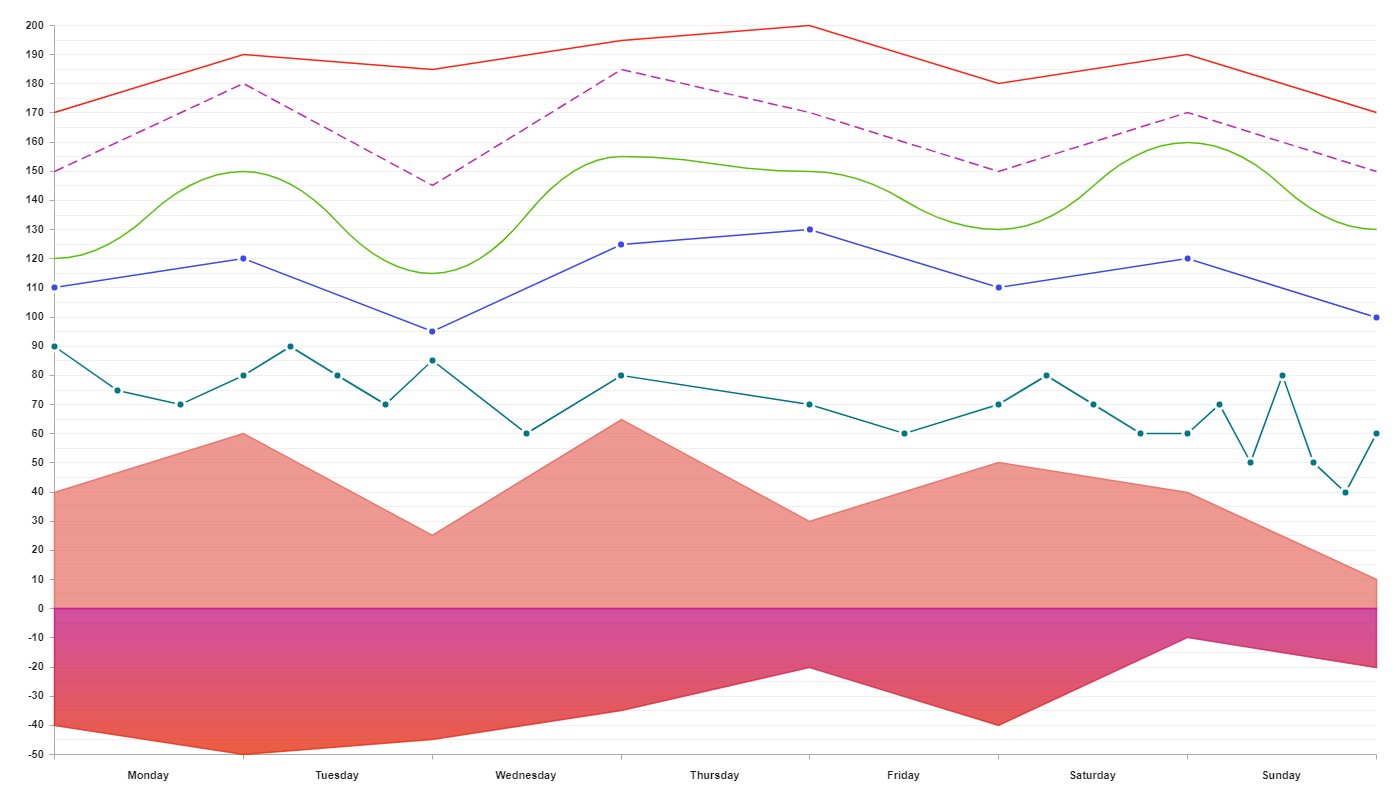
Example 2
You can also create many charts in one LineChart. They will have same properties like smooth, dots, fill and dashLine.
Code
let chart = new LineChart({
smooth: true,
dots: true,
values: [{
color: '#FF2212',
values: [70,90,85,95,100,80,90,70]
},{
color: '#3164C2',
values: [40,50,35,50,50,30,70,40]
},{
color: ['#44C219', '#138000'],
values: [20,-40,-85,-95,-40,-20,30,50]
},{
color: '#B30EC2',
values: [-70,-40,-35,-5,10,-20,-40,-70]
}]
})
Output
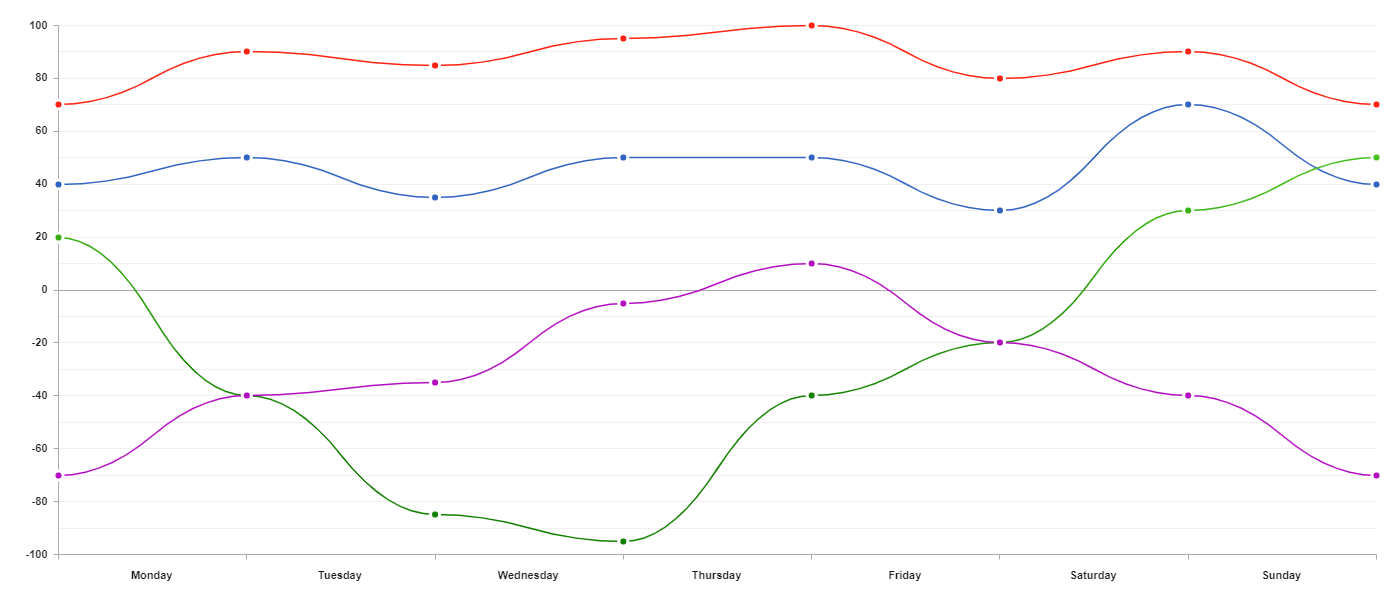
ColumnChart
Click here to jump Chart methods
- values - Each object in array is single item or item group.
Item object:
- type:
- 'simpe' - single column.
- 'group' - items group placed next to each other.
- 'stacked-group' - items group put on each other
- color - If its simple item you can use string or string array. If you use string it take its value as color. If you pass string array it will create gradient from this colors. If its group or stacked-group you should use array string of colors same as in simple item. Each item color will be aply to the value with same iterator.
- values - If you are using simle item you shuold use number. Otherwise you should use array of numbers.
- margin - You can only use it if item's type is group. If you don't want to have margin between items in group use margin: 'collapse'. Otherwise leave it blank.
- direction - You can only use it if item's type is stacked-group. You can't use negative numbers in stacked-group but if you want to make them negative use direction: 'reverse'.
- id - By this id you will be able to manage you item.
- name - It is the title of your item. It will allow you automaticly create label from your chart.
- type:
- correspondTo - By this you can choose to witch label it will be corresponding to.
- correspondToSecondary - By this you can choose witch label will be signature label.
- factor - more about facotrs
Code
interface ColumnChart({
values?: [{
type: string,
color: string | string[] | [string | string[]],
values: number | number[],
margin?: string,
direction?: string,
id?: string | number,
name?: string
}],
correspondTo?: string,
correspondToSecondary?: string,
factor?: ChartFactor
});
let chart = new ColumnChart({
values: [{
type: 'simple',
color: '#FF2212',
values: 60
},{
type: 'simple',
color: ['#FF2212','#801204'],
values: 70
},{
type: 'group',
color: ['#FF2212','#3164C2'],
values: [30, 50]
},{
type: 'group',
color: ['#FF2212','#3164C2'],
values: [80, 70],
margin: 'collapse'
},{
type: 'stacked-group',
color: ['#FF2212','#3164C2'],
values: [20, 80],
},{
type: 'stacked-group',
color: [['#FF2212','#801204'],['#3164C2','#1B0E80']],
values: [60, 40]
}]
});
Output
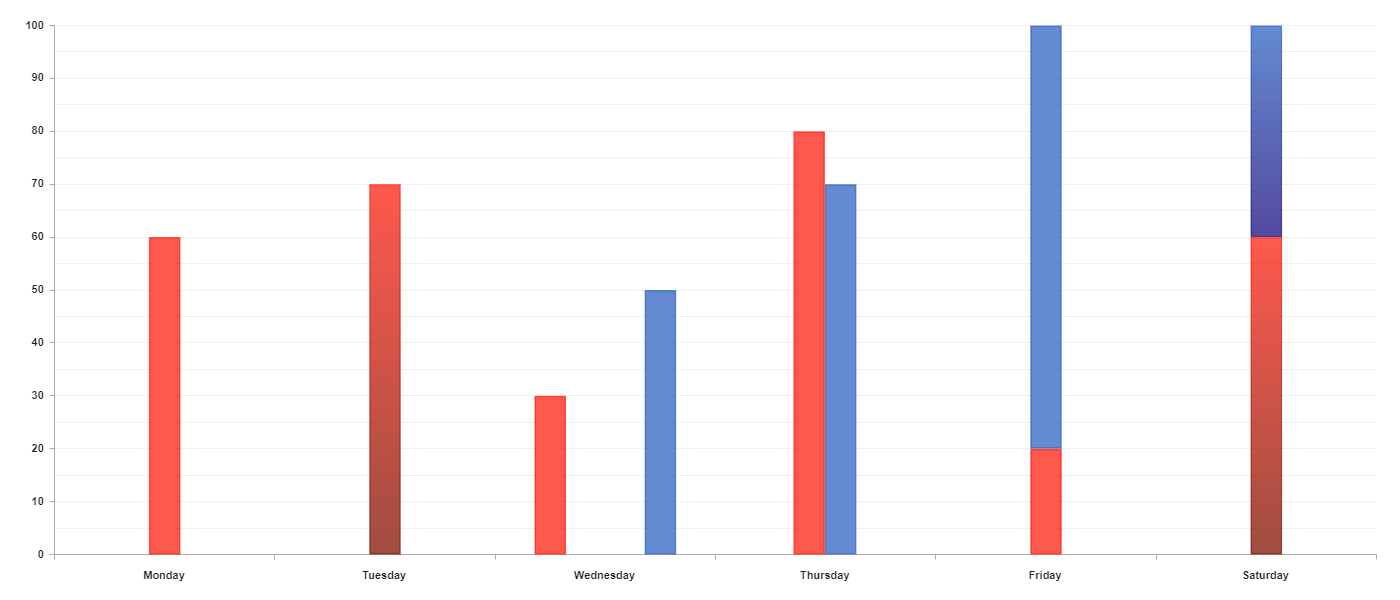
RowChart
Click here to jump Chart methods
- values - Each object in array is single item or item group.
Item object:
- type:
- 'simpe' - single column.
- 'group' - items group placed next to each other.
- 'stacked-group' - items group put on each other
- color - If its simple item you can use string or string array. If you use string it take its value as color. If you pass string array it will create gradient from this colors. If its group or stacked-group you should use array string of colors same as in simple item. Each item color will be aply to the value with same iterator.
- values - If you are using simle item you shuold use number. Otherwise you should use array of numbers.
- margin - You can only use it if item's type is group. If you don't want to have margin between items in group use margin: 'collapse'. Otherwise leave it blank.
- direction - You can only use it if item's type is stacked-group. You can't use negative numbers in stacked-group but if you want to make them negative use direction: 'reverse'.
- id - By this id you will be able to manage you item.
- name - It is the title of your item. It will allow you automaticly create label from your chart.
- type:
- correspondTo - By this you can choose to witch label it will be corresponding to.
- correspondToSecondary - By this you can choose witch label will be signature label.
- factor - more about facotrs
Code
interface RowChart({
values?: [{
type: string,
color: string | string[] | [string | string[]],
values: number | number[],
margin?: string,
direction?: string,
id?: string | number,
name?: string
}],
correspondTo?: string,
correspondToSecondary?: string,
factor?: ChartFactor
});
let chart = new RowChart({
values: [{
type: 'simple',
color: '#FF2212',
values: 60
},{
type: 'simple',
color: ['#801204','#FF2212'],
values: 70
},{
type: 'group',
color: ['#FF2212','#3164C2'],
values: [30, 50]
},{
type: 'group',
color: ['#FF2212','#3164C2'],
values: [80, 70],
margin: 'collapse'
},{
type: 'stacked-group',
color: ['#FF2212','#3164C2'],
values: [20, 80],
},{
type: 'stacked-group',
color: [['#801204','#FF2212'],['#1B0E80','#3164C2']],
values: [60, 40]
}]
});
Output
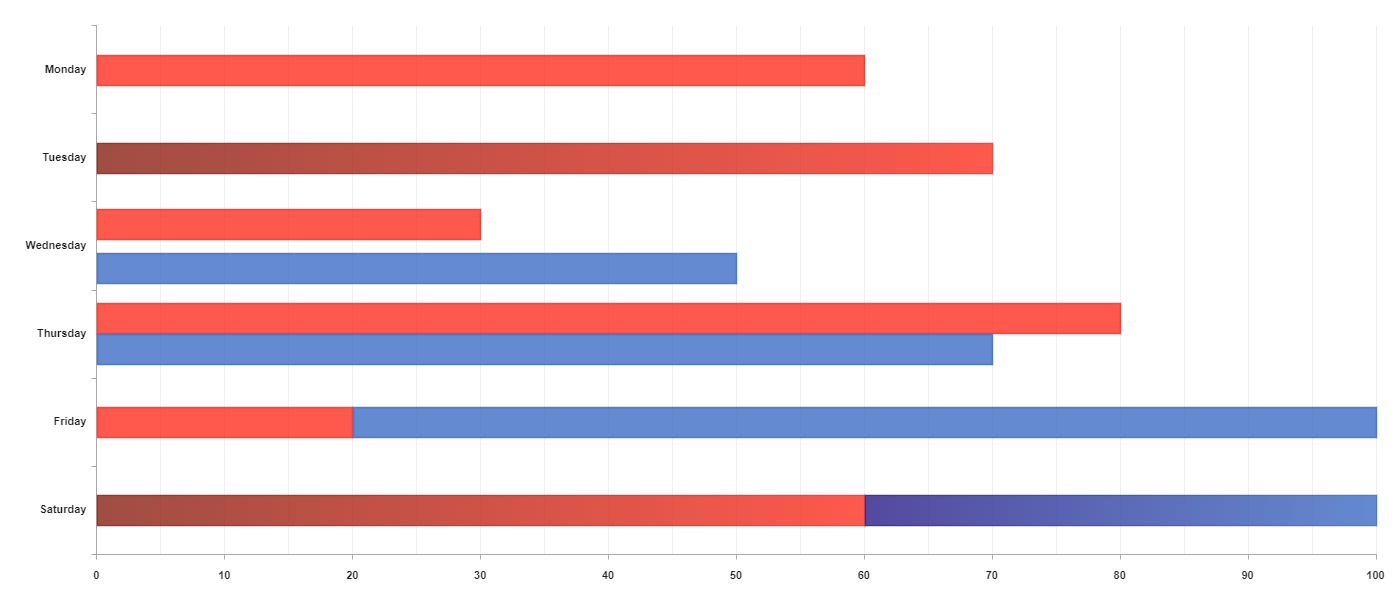
BubleChart
Click here to jump Chart methods
- values - Each object in array is single buble.
Item object:
- color - If you pass string it take its value as color. If you pass string array it will create gradient from this colors.
- values - Array of coordinates. First item is x coordinate and second item is y coordinate.
- radius - Radius of the buble.
- id - By this id you will be able to manage you item.
- name - It is the title of your item. It will allow you automaticly create label from your chart.
- factor - more about facotrs
Code
interface BubleChart({
values?: [{
color: string | string[],
values: number[],
radius: number,
id?: string | number,
name?: string
}],
factor?: ChartFactor
});
let chart = new BubleChart({
values: [{
values: [40, 50],
color: '#E61B00',
radius: 40
},{
values: [-40, 20],
color: '#BF009F',
radius: 160
},{
values: [20, 70],
color: '#1D4CC2',
radius: 50
},{
values: [-10, 20],
color: '#00C22D',
radius: 100
},{
values: [-40, -50],
color: '#FF9500',
radius: 10
},{
values: [20, -60],
color: ['#C2445B','#80182B'],
radius: 60
}]
});
Output
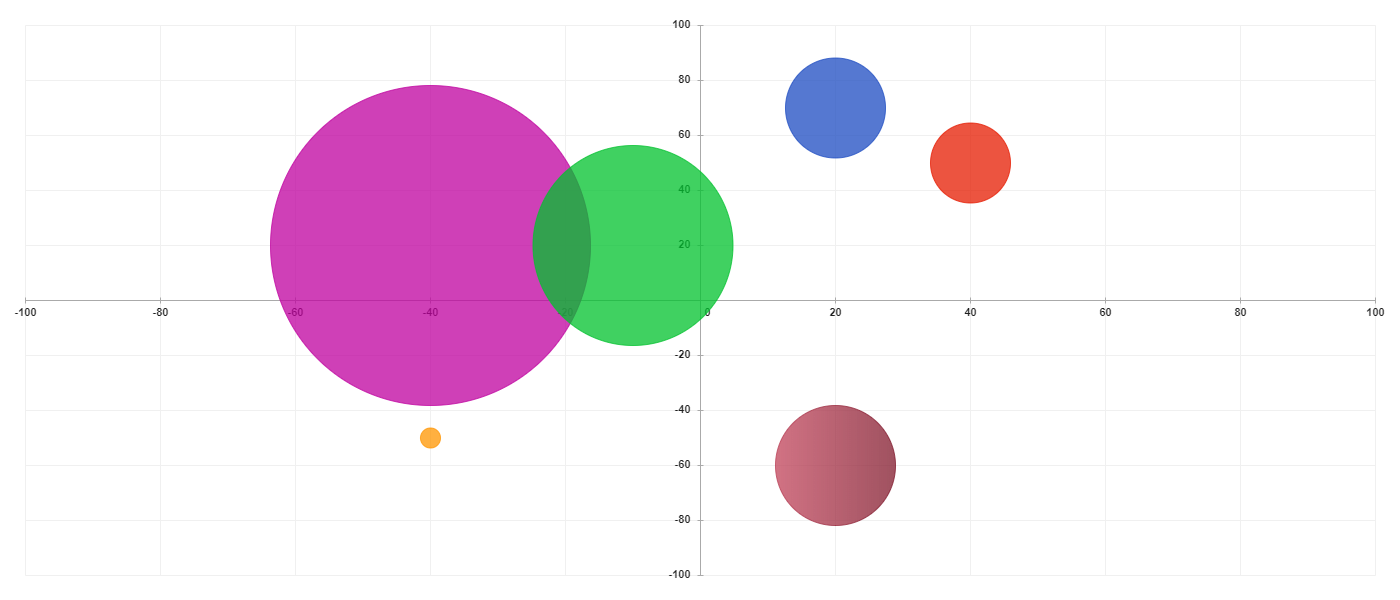
RangeChart
Click here to jump Chart methods
- values - Each object in array is single line or pionts.
Item object:
- color - If you pass string it take its value as color. If you pass string array it will create gradient from this colors.
- values - If you pass number array you will create points on grid. If you pass array of number array you will create ranges where start is first item of nested array and end is the second one.
- under - If you set this value to true line will be below grid.
- id - By this id you will be able to manage you item.
- name - It is the title of your item. It will allow you automaticly create label from your chart.
- factor - more about facotrs
Code
interface RangeChart({
values?: [{
color: string | string[],
values: [number | number[]],
under?: boolean,
id?: number | string,
name?: string
}],
factor?: ChartFactor
});
let chart = new RangeChart({
values: [{
values: [0, 100],
color: '#E6372E'
},{
values: [50, [-40,10]],
color: '#1954C2'
},{
values: [[Infinity,70]],
color: ['#80182B','#FF3056'],
under: true
},{
values: [[Infinity, Infinity]],
color: '#3CC247'
}]
});
Output
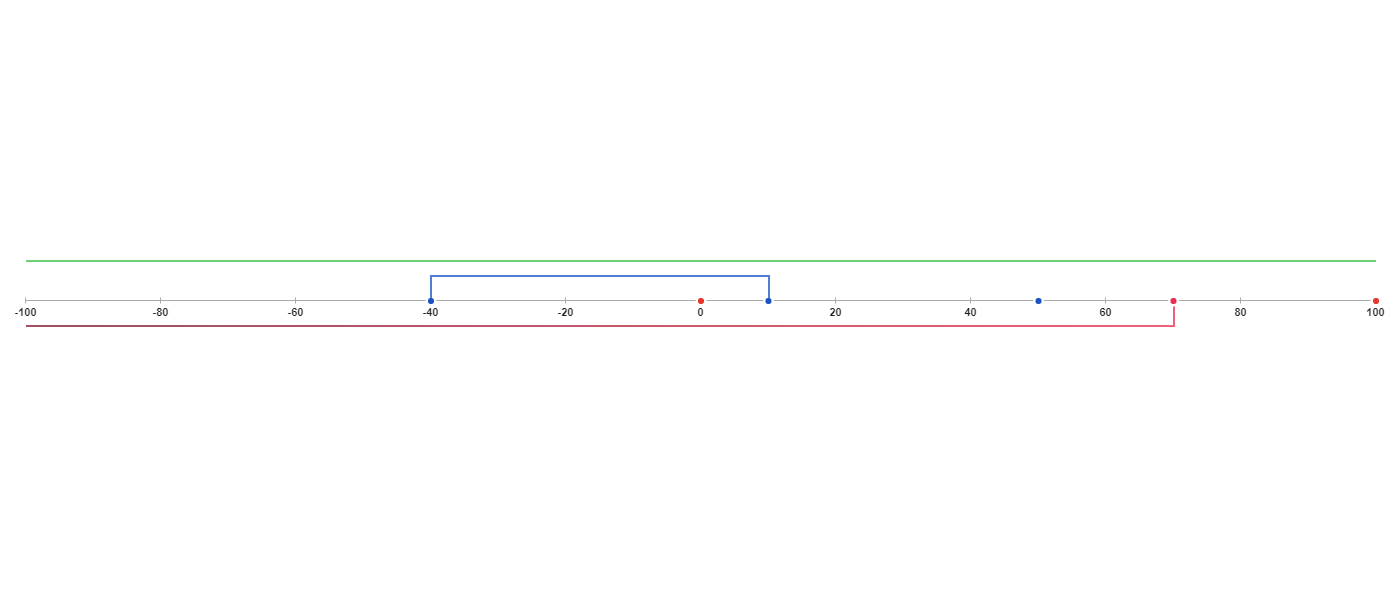
PolygonChart
Click here to jump Chart methods
- values - Each object in array is single polygon.
Item object:
- color - If you pass string it take its value as color. If you pass string array it will create gradient from this colors.
- values - It takes number array where each item in array points to the vertex.
- id - By this id you will be able to manage you item.
- name - It is the title of your item. It will allow you automaticly create label from your chart.
- factor - more about facotrs
Code
interface PolygonGrid({
values?: [{
color: string | string[],
values: number[],
id?: number | string,
name?: string
}],
dots?: boolean,
fill?: boolean,
factor?: ChartFactor
});
let chart = new PolygonChart({
values: [{
color: 'red',
values: [100,80,65,70,50]
}]
});
Output

RoundChart
Click here to jump Chart methods
- values - Each object in array reprezents piece of circle.
Item object:
- color - If you pass string it take its value as color. If you pass string array it will create gradient from this colors.
- values - This value determines the size of the circle piece. It is given as a percentage.
- id - By this id you will be able to manage you item.
- name - It is the title of your item. It will allow you automaticly create label from your chart.
- labels - Creates labels around the chart.
- centerValue - Adds some string to the center of the chart.
- changingSize - Each next item will be a little bit smaller.
- blankCenter - Creates empty space in the center of the chart.
- itemsMargin - Creates some spacing between items.
- canvas - HTML canvas element.
- changingStepSize - Specifies how item will be changing his size.
- centerRadius - Specifies size of the blank center. It is given as number from 0 to 1.
- factors - more about facotrs
Example 1
Code
interface RoundChart({
values?: [{
color: string | string[],
values: number,
id?: number | string,
name?: string
}],
labels?: StringLabel,
centerValue?: string,
changingSize?: boolean,
blankCenter?: boolean,
itemsMargin?: number,
canvas?: HTMLCanvasElement,
changingStepSize?: number,
centerRadius?: number,
factors?: ChartFactor
});
let chart = new RoundChart({
values: [{
color: '#E60400',
values: 40
},{
color: '#FF6A00',
values: 30
},{
color: ['#801B70','#FF36E1'],
values: 30
}]
});
Output
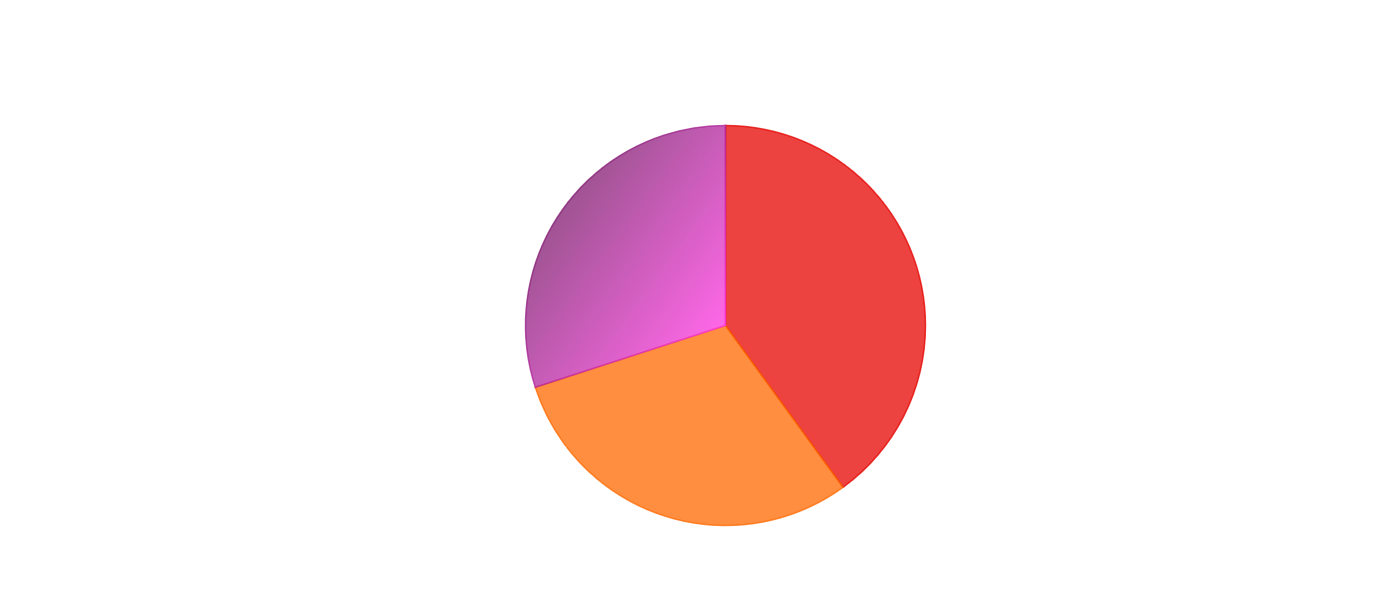
Example 2
Code
let chart = new RoundChart({
blankCenter: true,
centerValue: '100%',
changingSize: true,
itemsMargin: 10,
labels: new StringLabel(['dogs', 'cats', 'snakes']),
values: [{
color: '#E60400',
values: 40
},{
color: '#FF6A00',
values: 30
},{
color: ['#801B70','#FF36E1'],
values: 30
}]
});
Output
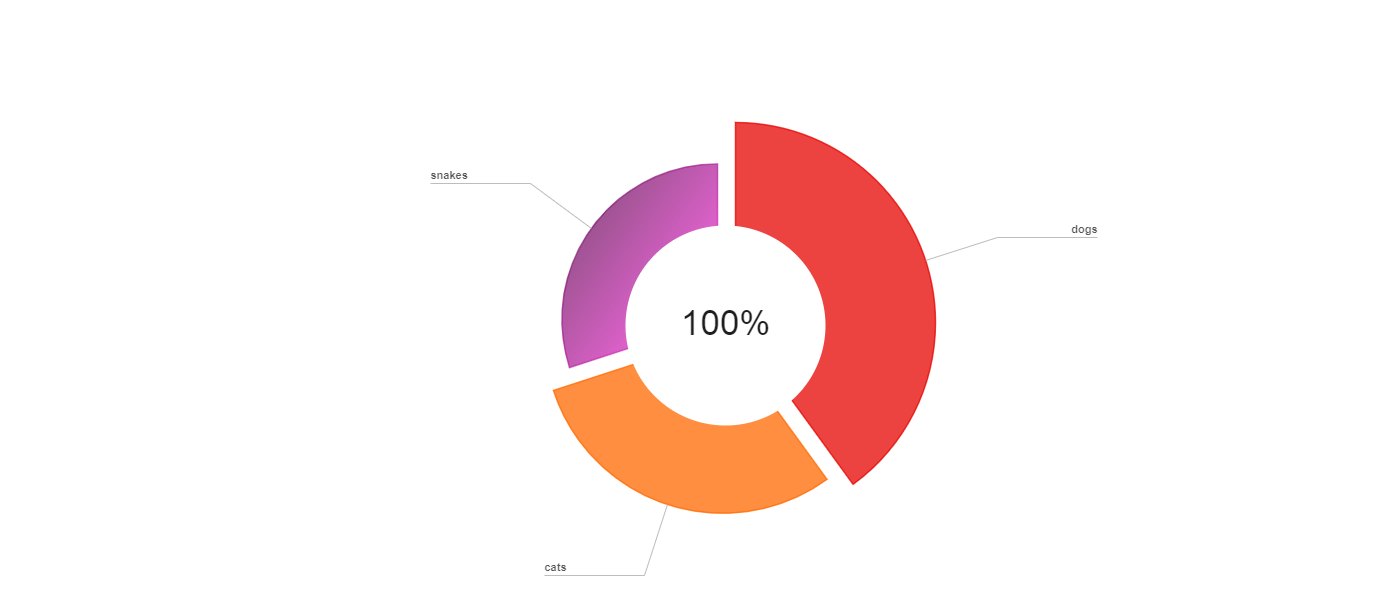
SameDirectionRoundChart
Click here to jump Chart methods
- values - Each object in array reprezents single item.
Item object:
- color - If you pass string it take its value as color. If you pass string array it will create gradient from this colors.
- values - This value determines the size of the circle. It is given as a percentage.
- id - By this id you will be able to manage you item.
- name - It is the title of your item. It will allow you automaticly create label from your chart.
- lables - Creates items label.
- centerValue - Adds some string to the center of the chart.
- canvas - HTML canvas element.
- itemMargin - Margin between items.
- factor - more about facotrs
Example 1
Code
interface SameDirectionRoundChart({
values?: {
color: string | string[],
values: number,
id?: number | string,
name?: string,
},
lables?: StringLabel,
centerValue?: string,
canvas?: HTMLCanvasElement,
itemMargin?: number,
factor?: ChartFactor
});
let chart = new SameDirectionRoundChart({
values: [{
color: '#E61700',
values: 40
},{
color: '#2155BF',
values: 60
},{
color: ['#1D8012','#2DC21C'],
values: 70
},{
color: '#C23167',
values: 90
}]
});
Output
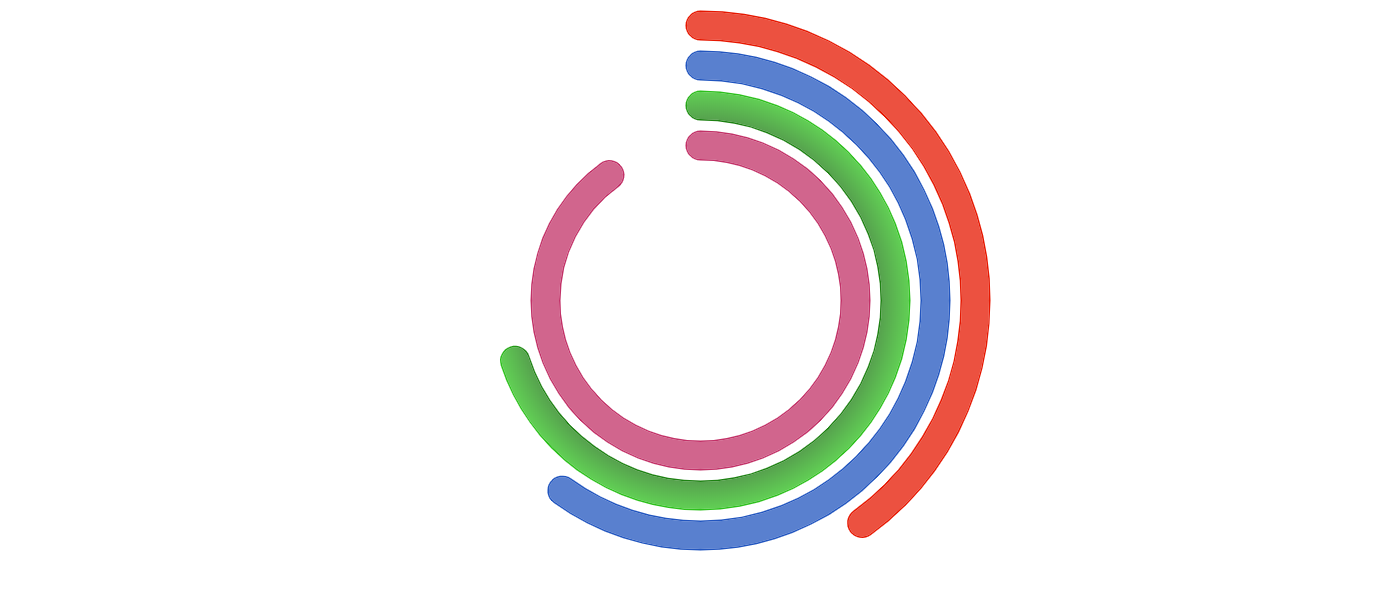
Exapmle 2
Code
let chart = new SameDirectionRoundChart({
labels: new StringLabel(['cats','dogs','snakes','birds']),
centerValue: '76.3%',
values: [{
color: '#E61700',
values: 40
},{
color: '#2155BF',
values: 60
},{
color: ['#1D8012','#2DC21C'],
values: 70
},{
color: '#C23167',
values: 90
}]
});
Output
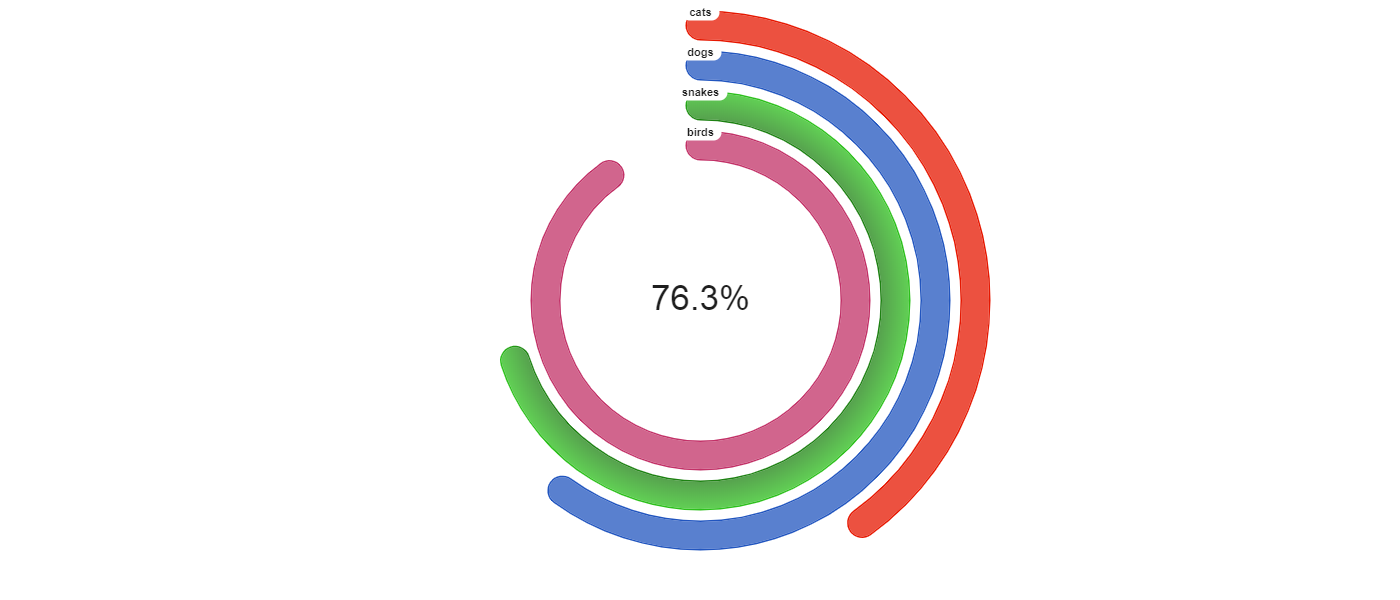
Factors
You can use factors to define your grids or charts styles. You can create new factor and apply it to the grid or chart. Or you can modify the default one that will affect all of them.
GridFactor
If you want to use it all you have to do is to create new instance of it and pass it to grid object.
- colors:
- primary - It's a color of your main borders. Like separators between label and charts or position of your 0 value.
- secondary - It's a color of the rest of the borders.
- font:
- size - Changes size of your font.
- family - Changes font family of your font.
- color - Changes color of your font.
- background:
- color - Changes background color of your canvas.
- image - You can add image as a background. It's a path to your image.
- opacity -
- labelPadding - Defines size of maring between label and grid.
Code
interface GridFactor({
colors?: {
primary?: string;
secondary?: string;
},
font?: {
size?: number;
family?: string;
color?: string;
},
background?: {
color?: string;
image?: string;
opacity?: number;
},
labelPadding?: number;
});
ChartFactor
If you want to use it all you have to do is to create new instance of it and pass it to grid object.
- lineWidth - Defines width of all charts lines.
- opacity - Allows your to control transparency of your chart.
- itemSize - Defines size of items like column width etc...
- dotBorder - Creates space between dots and lines.
- dotRadius - Defines radius of all dots on charts.
Code
interface ChartFactor({
lineWidth?: number,
opacity?: number,
itemSize?: number,
dotBorder?: boolean,
dotRadius?: number
});
Default factors
By modifying this object you can affect styles for all your grids or charts.
DEFAULT_GRID_FACTOR - default factor for grid. It's GridFactor instance. DEFAULT_CHART_FACTOR - default factor for charts. It's ChartFactor instance.
More
Combained chart example
Code
let grid = new HorizontalGrid(canvas, {
left: new FlexLabel(100, 0, 10),
bottom: new StringLabel(['2019','2020','2021','2022','2023'])
});
grid.addCharts({
columns: new ColumnChart({
values: [{
type: 'group',
color: [['#E62200','#801300'],['#0B89BF','#085C80']],
values: [30, 40],
margin: 'collapse'
},{
type: 'group',
color: [['#E62200','#801300'],['#0B89BF','#085C80']],
values: [50, 30],
margin: 'collapse'
},{
type: 'group',
color: [['#E62200','#801300'],['#0B89BF','#085C80']],
values: [80, 90],
margin: 'collapse'
},{
type: 'group',
color: [['#E62200','#801300'],['#0B89BF','#085C80']],
values: [100, 70],
margin: 'collapse'
},{
type: 'group',
color: [['#E62200','#801300'],['#0B89BF','#085C80']],
values: [95, 76],
margin: 'collapse'
}]
}),
lines: new LineChart({
dots: true,
smooth: true,
moveToCenter: true,
dashLine: [10, 5],
values: [{
color: ['#E62200','#801300'],
values: [30,50,80,100,95]
},{
color: ['#0B89BF','#085C80'],
values: [40,30,90,70,76]
}]
})
})
grid.draw();
Output
